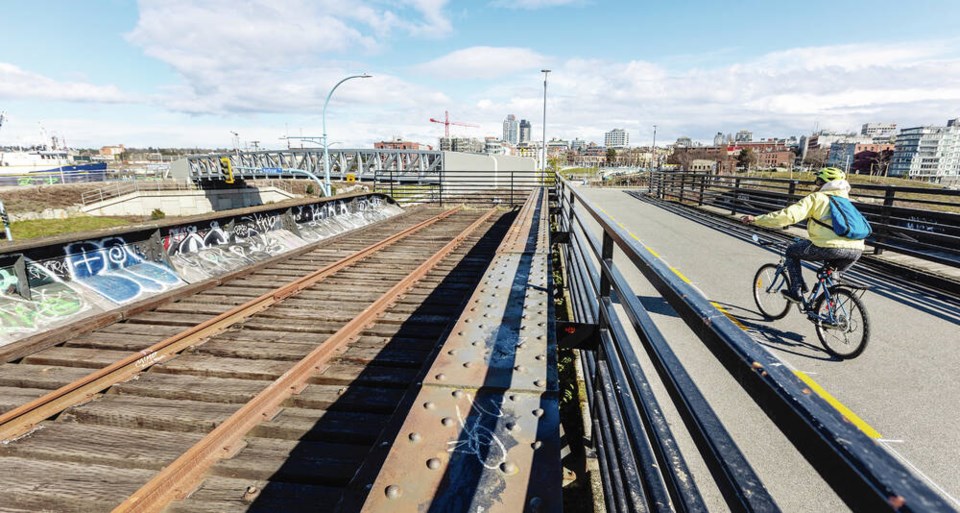Chief Gordon Edwards of Snaw-Naw-As (Nanoose) First Nation called Tuesday a “historic day,” as the federal and provincial governments announced plans to return 10-plus acres taken from the First Nation in the early 1900s to launch the now closed E&N rail line.
“There are many questions about what lies ahead for the rest of the [rail] corridor but for today we celebrate the successful return of our land,” Edwards (Sul-aux-Mait) said in a statement Tuesday.
“I look forward to seeing what else is possible for our community, other First Nations, and the corridor as a whole, without having an unused rail [line] in our way.”
Edwards said the nation plans to get to work “immediately to ensure that the railway no longer impedes our community’s safety, development and access.”
Calls for the return of the land, which cuts through the Snaw-Naw-As reserve, were the subject of a court case that ended with the B.C. Court of Appeal directing the federal government to weigh in on whether it plans to fund the relaunch of rail service.
Edwards said the legal case was started by past leaders, some of whom have since passed away.
The court had set Tuesday as the deadline for the federal government to decide whether it would support a proposed new modern rail system on the corridor lands running between Victoria and Courtenay.
Without making any promises about that concept, the federal and provincial government announced support Tuesday for future planning on the corridor.
Removing the Nanoose portion of the corridor means that if a rail system or other uses — such as a trail for pedestrians and cyclists — proceed, an alternate route would be needed. The possibility of changing the route of the corridor has been raised in the past.
It remains to be seen if other First Nations will seek the return of their lands taken for the corridor.
Songhees Chief Ron Sam said his nation fully supports Nanoose in its efforts to regain its land.
The province has promised $18 million for future planning by First Nations and regional districts, which together own the corridor and make up the Island Corridor Foundation. No federal funding was announced.
Premier David Eby said at a news conference in Vancouver that the return of the land does not mark the end of the line for the corridor. “This is the beginning of the work, in a different way, in a way that all of our projects and land use decisions need to work in this province, in partnership with First Nations.”
Eby said the rail line was built by a private company that was given massive tracts of land in south Vancouver Island in exchange for building the railway.
“That land belongs to First Nations and the rail line itself cut right through the middle of communities, divided reserves, as small they were, up and down the island,” said Eby, who called it a “gross injustice.”
“The fact that the land is reverting to First Nations is absolutely the right thing.”
While the provincial government would like to see the corridor continue to be used for transportation, it also wants to “support First Nations in the direction that they think is most appropriate for the corridor,” he said.
B.C. Transportation Minister Rob Fleming said the government recognizes how important the corridor is and would like to see it preserved as much as possible. “If the corridor is broken up and built over, it will be lost forever, and future generations will likely be unable to assemble a continuous transportation corridor or land like this again.”
The Island Corridor Foundation said it will review the senior governments’ decisions before making any statements.
“We remain committed, as we always have been, to the principles and spirit of reconciliation and will work with government and First Nations on a shared vision for the corridor,” it said.
What lies ahead for the foundation is unknown. Four of the five First Nations members on its board quit recently to protest its pro-rail stance.
Supporters of a new modern rail system said it would help boost the Island’s economy through freight and passenger service and by enhancing tourism.
Rail opponents favour using the corridor as a trail for cyclists and pedestrians. A fleet of electric buses operating on highways would make a more environmentally friendly option than rail, said Alastair Craighead, chair of Friends of Rail to Trail Vancouver Island. “The Island corridor has been subject to years of neglect because there has been no business case for funding rail service for the Island’s small population base.”
Going forward, the foundation can choose to exclude rail in favour of trails, Craighead said. While there is no federal money for rail, he said, there is a $400 million active-transportation fund for projects such as creating pathways, bike lanes, trails and more.
Kimberly Speers, assistant teaching professor with the University of Victoria’s school of public administration, said the senior governments have taken an important step in terms of returning land to the First Nation and realizing that further engagement needs to happen.
But given the complexity of issues surrounding the corridor, Speers said discussions could continue for another decade. “What’s the next deadline? Is there a deadline?”
Relationship-building will have to be front and centre when it comes to the future of the Island Corridor Foundation, said Speers, who expects other First Nation to also seek the return of land.
“There’s going to be winners and there is going to be losers and that is why I think is is very difficult for either order of government to make a decision right now.”
cjwilson@timescolonist.com
— With files from Cindy E. Harnett
>>> To comment on this article, write a letter to the editor: letters@timescolonist.com



